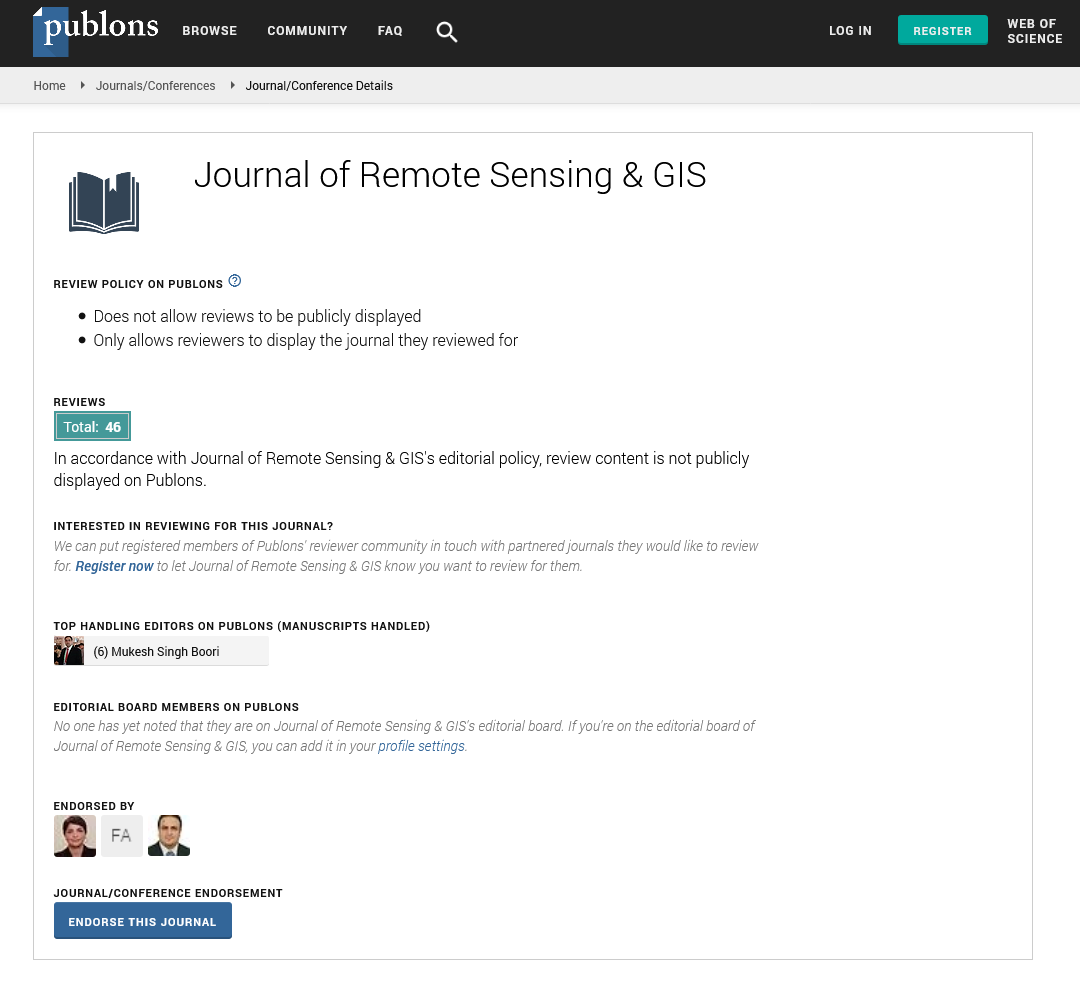Indexed In
- Open J Gate
- RefSeek
- Hamdard University
- EBSCO A-Z
- OCLC- WorldCat
- Publons
- International Scientific Indexing
- Euro Pub
- Google Scholar
Useful Links
Share This Page
Journal Flyer

Open Access Journals
- Agri and Aquaculture
- Biochemistry
- Bioinformatics & Systems Biology
- Business & Management
- Chemistry
- Clinical Sciences
- Engineering
- Food & Nutrition
- General Science
- Genetics & Molecular Biology
- Immunology & Microbiology
- Medical Sciences
- Neuroscience & Psychology
- Nursing & Health Care
- Pharmaceutical Sciences
Perspective - (2024) Volume 13, Issue 3
Multi-Temporal Analysis of Land Use and Land Cover Changes using Remote Sensing and GIS
Levant Wilson*Received: 26-Aug-2024, Manuscript No. JGRS-24-26972; Editor assigned: 29-Aug-2024, Pre QC No. JGRS-24-26972 (PQ); Reviewed: 13-Sep-2024, QC No. JGRS-24-26972; Revised: 20-Sep-2024, Manuscript No. JGRS-24-26972 (R); Published: 27-Sep-2024, DOI: 10.35248/2469-4134.24.13.354
Description
Land Use and Land Cover (LULC) changes have significant impacts on the environment, ecosystem services and socio-economic activities. Monitoring these changes is important for effective management of natural resources and urban planning. Remote Sensing (RS) and Geographic Information System (GIS) are powerful tools for analyzing LULC changes over time. This integrates multi-temporal satellite imagery, supervised classification and change detection techniques to assess land cover transformations across different periods. The results highlight patterns of urban expansion, deforestation and agricultural intensification, providing valuable insights for land management and policy formulation. Monitoring LULC changes is important for understanding environmental processes such as deforestation, urbanization, soil erosion and climate change. These changes can lead to adverse impacts such as loss of biodiversity, alteration of hydrological cycles and increased carbon emissions.
Remote sensing (RS) and Geographic Information System (GIS) technologies forms a strong framework for multi-temporal analysis of LULC changes. RS provides access to time-series satellite imagery, while GIS allows for the spatial analysis and mapping of LULC data. By integrating these technologies, researchers and decision-makers can detect changes in land use patterns over time, analyze their causes and impacts and develop effective management strategies.
The first step in the multi-temporal analysis is acquiring remote sensing data from reliable satellite sources. For this study, Landsat data (e.g., Landsat 5, Landsat 7 and Landsat 8) with 30- meter spatial resolution were utilized due to their temporal consistency and availability. Data was collected for specific time periods, typically spaced by intervals of 5-10 yrs, allowing for the observation of long-term trends in LULC changes.
Data preprocessing
Data preprocessing is essential to ensure the quality and consistency of satellite imagery for accurate analysis. The preprocessing steps include geometric correction, atmospheric correction and radiometric calibration. Geometric correction aligns the satellite images to a common coordinate system, while atmospheric correction removes distortions caused by atmospheric interference. Radiometric calibration ensures that the images from different time periods are comparable by adjusting for sensor sensitivity and lighting conditions.
Image classification
Image classification is the process of categorizing pixels in the satellite images into LULC classes. This study utilized a supervised classification technique using the Maximum Likelihood Classifier (MLC), which requires training data for each LULC class (e.g., forest, agriculture, urban, water bodies). The training data was collected through high-resolution imagery. The classified images were validated using accuracy assessment methods, such as the confusion matrix and kappa coefficient, to ensure reliable classification results.
Change detection
Once the LULC maps were generated for each time period, change detection analysis was performed to identify and quantify LULC changes. This involves comparing the classified images from different time periods to detect transitions between LULC classes. The change detection methods used in this study included post-classification comparison and image differencing. Post-classification comparison involves comparing two independently classified images, while image differencing calculates the spectral differences between images.
Conclusion
The multi-temporal analysis of LULC changes using remote sensing and GIS revealed profound transformations in the study area. Urban expansion, deforestation and agricultural intensification were the dominant land cover changes observed over the past few decades. These changes underscore the need for sustainable land management practices and policies that balance economic development with environmental conservation. Remote sensing and GIS proved to be invaluable tools for monitoring and analyzing LULC changes, offering insights that can inform landuse planning and policy decisions. Future research should focus on integrating socio-economic data with remote sensing analysis to better understand the drivers of land cover change and their broader impacts.
Citation: Wilson L (2024). Multi-Temporal Analysis of Land Use and Land Cover Changes using Remote Sensing and GIS. J Remote Sens GIS. 13:354.
Copyright: © 2024 Wilson L. This is an open-access article distributed under the terms of the Creative Commons Attribution License, which permits unrestricted use, distribution and reproduction in any medium, provided the original author and source are credited.

